Building A Trail Is Like Gardening (Only More Violent)
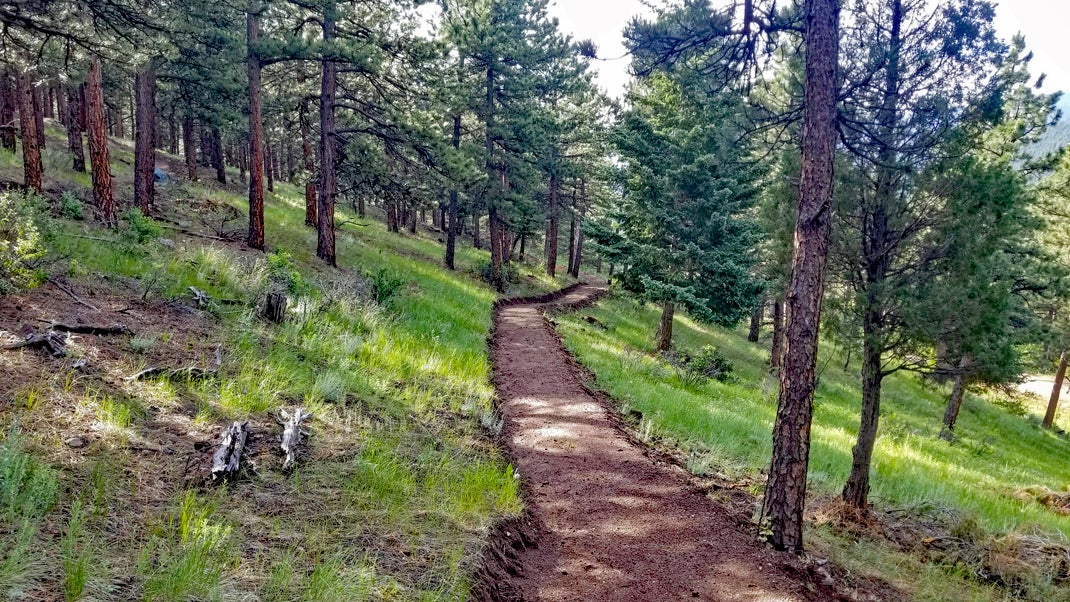
(Photo: James Dziezynski)
Reflecting on the aggro-zen of years spent building trails into the side of a mountain.
50 years ago you used to be able to buy sticks of dynamite at your local hardware store.
It’s true: You could walk right up to the counter, say “Dynamite, please,” be handed a few sticks, primers, a fuse, and you’d be on your way home, ready to blast the object of your scorn — stump, boulder, yard gnome — to bits. Alas, those days are gone.
The lack of dynamite in my life generally wasn’t an issue—at least not until I started building trails on my mountainside property in Colorado in 2015. Turns out the stuff would have been mighty helpful.
I had a dream, a dream of an honest mile of trails on my own land. Trails made perfect for a quick mountain bike, a dog romp, a winter snowshoe, or a simple hike with a friend.
I’d have to be creative with switchbacks and climbing turns to make it work. I needed to craft paths with the topography handed to me, carving out lines between trees, always wary of invincible boulders and defiant underground stumps lurking beneath the carapace of ancient pine needles.
I burned through three pickaxes, four metal rakes, and at least 20 pairs of gloves over five years of hard trail work. If offered a bundle of dynamite that would’ve transformed a multi-day project into a 30-second explosion, I wouldn’t have turned it away.
Blood, Sweat, and Cicadas
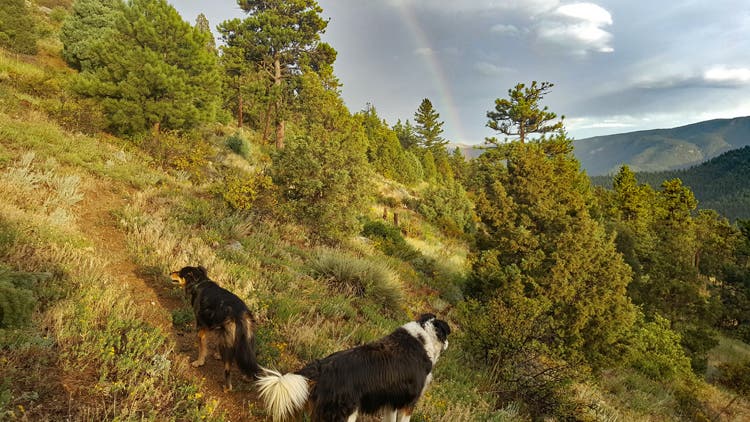
The canvas for my trails was an old mining claim, a modest 5-acre plot in the foothills west of Boulder, Colorado, and as steep as a blue ski run. Beyond of a single flat shelf (hewn in the early 1900s courtesy of dynamite), there was no level ground to speak of. This was going to be… work.
According to county records, two mines operated on our land between 1890 and 1930. One was a puny hole in the ground that supposedly yielded nothing more than a single booger of gold. The other one, which is wide enough to drive an SUV into the hillside, produced tungsten. I soon learned that while tungsten lacks gold’s status, it makes up for it in tensile strength.
Our land is riddled with tungsten-infused granite, a kind of super rock that laughs at pick-axes and chisels. Striking one of these stones with a pick-ax instantly results in a very distinct sensation of numb pinky fingers. More than once, these über-boulders made me want to quit the project and move to the flats of Nebraska, where all one needs to build a trail is a dirt bike with knobby tires.
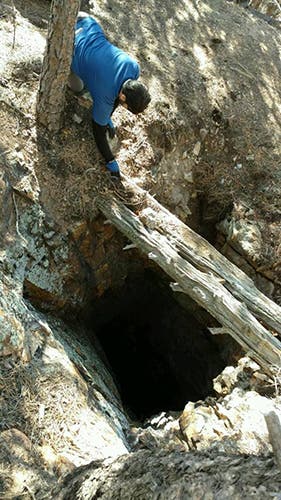
There were other difficulties. Summer days could be witheringly hot, oftentimes because I had to chainsaw down the only sources of shade in the name of fire mitigation. Wildfire smoke’s seasonal regularity and afternoon lightning storms often canceled hard-won free time set aside for trail building. In the summer of 2021, a scourge of cicadas falling from the trees rained down on my shirt, pants, and boots. They were plentiful enough to require retreat more than once. I often found them when running my fingers through my hair in the shower hours after I had put my tools away.
Gardening for Angry People
Trail building has a lot in common with gardening. It offers hours spent outdoors in sun and shade physically connecting with raw soil, an unapologetic license to get dirty, and the chance to shape a small parcel of planet Earth with one’s own hands. Like gardening, trail building requires patience; rushing the details will result in a poor yield. Like gardening, the work is never really done.
That’s the zen part.
The angry part is there’s no way of knowing if the day’s labor will create 200 feet of level, smooth trail or five feet of lumpy, ugly futility. But once one lets go of outcomes, the hyper-present focus of the immediate “now” pays dividends for one’s sanity.
It’s hard work but I crave it. Trail work is purpose without complexity or expectation. And it’s a physical outlet that demands muscle and aggression. Trail work channels stress directly into the hide of the planet, where it is harmlessly diffused.
Nearly all the trails I’ve built were made using two simple tools: a 5-lb pick-ax and a metal rake. My special ops gear includes a crowbar (which I bent trying to dislodge one of the aforementioned tungsten-granite boulders), a hammer drill with a chisel, and on rare occasions, a bag of expanding concrete.
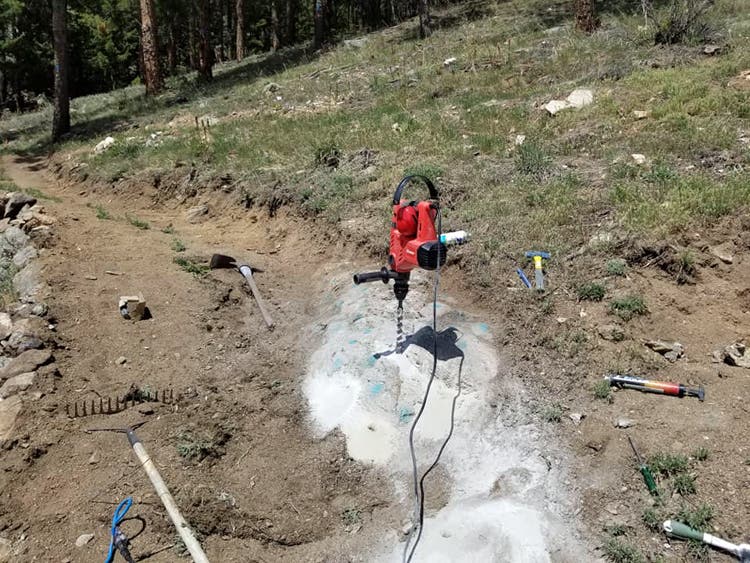
Expanding concrete mimics very slow-acting dynamite. You can shatter boulders by drilling holes into the rock with a hammer drill and filling the void with wet concrete. The concrete hardens over a couple of days and cracks the rock in a quasi-satisfying victory. There’s no explosion but the rock is nonetheless reduced to rubble.
I’ve acquired a fine collection of scars from errant pick strikes, unexpectedly rolling rocks, cactus thorns, petrified branches, and gritty tree bark. My forearms resemble the battle-damaged skin of Moby Dick.

2020 was a great year to sequester oneself in the woods and tune out a whole lot of madness from the world at large. My trail-building sessions are always accompanied by an audiobook played out loud to make me a little smarter and to give wildlife a heads-up. In that year alone, I listened to 37 different audiobooks, including four that were Great Courses editions on the Middle Ages, each over 30 hours long. Did you know that castle stairwells were designed with walls on the right so that ascending right-handed attackers couldn’t get in a full-power swing? Or that historians still don’t know why there are so many depictions of knights battling snails in medieval texts?
I spent a lot of time working on these trails.
I often lost track of the hours until encroaching darkness lit the first stars and planets against the dark gradient sky. I’ve been out in all seasons — hampered by frozen dirt and blazing sun, sometimes blessed by the rare cool, misty days that are my favorite. Sometimes I ponder thoughts great and small, other days I simply let the audiobook do the thinking for me. People pay for that kind of peace of mind.
The Magic Mile
I completed a full mile of rideable, hike-ready trails in the late summer of 2021. The work happened over a span of five years and included plenty of revisions and fine-tuning. I didn’t even realize I had a full mile until walking the trails with a mapping app that confirmed I had in fact surpassed my goal: 1.2 miles in total. I’ve been at it so long, I can see my trails cut into the land from the low-orbit eyes of Google’s satellites. There will be maintenance and more variations to build. But at long last, the core trails are done.
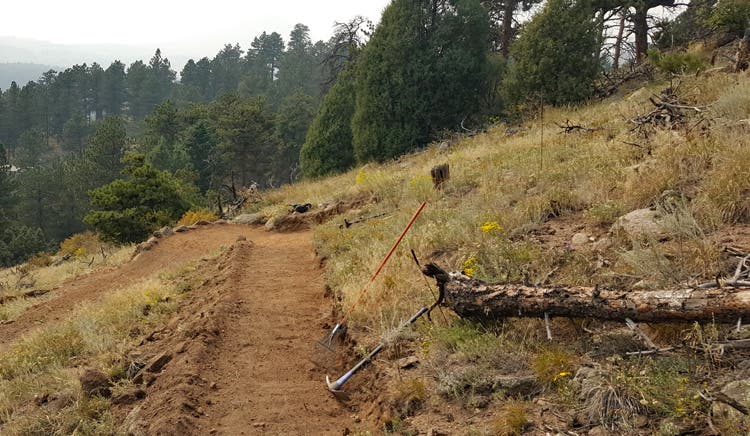
Trails offer a different harvest than gardens. I have created a journey through a forest on the side of a mountain. Here I can walk with my wife through the shadows and light, in times good and bad. Here I can spin my legs on my mountain bike and jolt my cardiovascular system into overdrive with a good run. Here I can see footprints of deer, turkeys, and foxes in freshly raked dirt. Here I can watch storms roll in over the western peaks.
And it is here, in a special cutout I carved out with extra care, that my wife and I laid down our beloved 17-year-old dog Mystic. He took his final breaths while looking out on mountains far and near that we had climbed together during some of the very best years of my life.
I can summon the ghosts of my past at each trail segment. I can remember the books I was listening to, my worries that day, hopes and fears, even the weather. The essence of an era is encoded in those trails. There is a hidden story carved into the ground, available only to me and those I share it with.
Looking forward, I anticipate the change of seasons and the company of friends in these woods. I’ve had my first moose visitor and I’ve been privileged to watch a hardscrabble family of robins mature in the crook of a dying ponderosa pine. I’ve seen a clumsy juvenile black bear grow into something more graceful and curious.
I have done my best, but who knows how long these trails will endure? Nature may one day reclaim them all. My hope is that one day an astute traveler—a human, a deer, a rabbit, it doesn’t matter to me—will recognize the intentional, unnatural flatness winding through the woods and for a moment, acknowledge the imagination and effort that gave life to this weathered passage they discovered. At that moment, I like to believe I will have attained a subtle sort of immortality, the kind that makes a small part of someone’s journey a little easier.